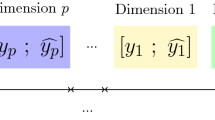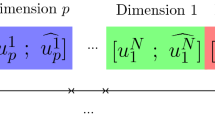Abstract
This research proposes the method to extract the characteristics of images to become the intervals. These intervals are used to build the automatic fuzzy genetic algorithm for images (AFGI). In the proposed model, the overlap measure is the criterion to evaluate the closeness of intervals, and the new Davies and Bouldin index is the objective function. The AFGI can determine the proper number of clusters, the images in each cluster, and the probability to belong to clusters of images at the same time. The experiments with different types of images illustrate the steps of AFGI, and show its significant benefit in comparing to other algorithms.
















Similar content being viewed by others
References
Arivazhagan S, Shebiah RN, Nidhyanandhan SS, Ganesan L (2010) Fruit recognition using color and texture features. Journal of Emerging Trends in Computing and Information Sciences 1(2):90–94
Bora DJ, Gupta AK (2014) Impact of exponent parameter value for the partition matrix on the performance of fuzzy c means algorithm. arXiv:1406.4007
Cabanes G, Bennani Y, Destenay R, Hardy A (2013) A new topological clustering algorithm for interval data. Pattern Recogn 46(11):3030–3039
Chen JH, Hung WL (2015) An automatic clustering algorithm for probability density functions. J Stat Comput Simul 85(15):3047–3063
Cheng HD, Shan J, Ju W, Guo Y, Zhang L (2010) Automated breast cancer detection and classification using ultrasound images: a survey. Pattern Recogn 43(1):299–317
Davies DL, Bouldin DW (1979) A cluster separation measure. IEEE Trans Pattern Anal Mach Intell (2):224–227
De Carvalho FDA, Pimentel JT, Bezerra LX (2007) Clustering of symbolic interval data based on a single adaptive l1 distance. In: Neural networks 2007, international joint conference, pp 224–229
De Souza RM, de Carvalho FDA, Silva FC (2004) Clustering of interval-valued data using adaptive squared euclidean distances. In: International conference on neural, pp 775–780
Eleyan A, Demirel H (2011) Co-occurrence matrix and its statistical features as a new approach for face recognition. Turk J Electr Eng Comput Sci 19(1):97–107
Engin MA, Cavusoglu B (2019) Rotation invariant curvelet based image retrieval & classification via Gaussian mixture model and co-occurrence features. Multimedia Tools and Applications 78(6):6581–6605
Fadl S, Megahed A, Han Q, Qiong L (2020) Frame duplication and shuffling forgery detection technique in surveillance videos based on temporal average and gray level co-occurrence matrix. Multimedia Tools and Applications 1–25
Ge Y, Yin BC, Sun YF, Jing GD (2014) Expansion of 3d face sample set based on genetic algorithm. Multimedia Tools and Applications 70(2):781–797
He Z, Ho C-H (2019) An improved clustering algorithm based on finite Gaussian mixture model. Multimedia Tools and Applications 78(17):24285–24299
Hubert L (1977) Nominal scale response agreement as a generalized correlation. Br J Math Stat Psychol 30(1):98–103
Hubert L, Arabie P (1985) Comparing clusterings. J Classif 2:193–218
Hung WL, Yang JH, Shen KF (2016) Self-updating clustering algorithm for interval-valued data. Fuzzy Systems 1494–1500
Holland JH (1973) Genetic algorithms and the optimal allocation of trials. SIAM J Comput 2(2):88–105
Jeng JT, Chen CM, Chang SC, Chuang CC (2019) IPFCM Clustering algorithm under Euclidean and Hausdorff distance measure for symbolic interval data. Int J Fuzzy Syst 21:2102–2119
Kabir S, Wagner C, Havens TC, Anderson DT, Aickelin U (2017) Novel similarity measure for interval-valued data based on overlapping ratio. Fuzzy Systems IEEE International Conference 1–6
Lai CC (2005) A novel clustering approach using hierarchical genetic algorithms. Intelligent Automation & Soft Computing 11(3):143–153
Liu Y, Wu X, Shen Y (2011) Automatic clustering using genetic algorithms. Appl Math Comput 218(4):1267–1279
Malarvizhi N, Selvarani P, Raj P (2019) Adaptive fuzzy genetic algorithm for multi biometric authentication. Multimedia Tools and Applications 1–14
Mirkin BG, Chernyi LB (1970) Measurement of the distance between distinct partitions of a finite set of objects. Autom Tel 5:120–127
Nair LR, Subramaniam K, Venkatesan GP (2019) An effective image retrieval system using machine learning and fuzzy c-means clustering approach. Multimedia Tools and Applications 1–18
Nguyen-Trang T, Tai VV (2017) A new approach for determining the prior probabilities in the classification problem by Bayesian method. ADAC 11(3):629–643
Patel HN, Jain R, Joshi MV (2011) Fruit detection using improved multiple features based algorithm. Int J Comput Appl 13(2):1–5
Peng W, Li T (2006) Interval data clustering with applications. In: Tools with artificial intelligence. 2006, 18th IEEE international conference, pp 355–362
Pham-Gia T, Turkkan N, Tai VV (2008) Statistical discrimination analysis using the maximum function. Communications in Statistics—Simulation and Computation®; 37(2):320–336
Rand WM (1971) Objective criteria for the evaluation of clustering methods. J Am Stat Assoc 66(336):846–850
Rodríguez SI, de Carvalho FD (2019) A new fuzzy clustering algorithm for interval-valued data based on city-block distance. In: 2019 IEEE International Conference on Fuzzy Systems, pp 1–6
Sara IRR, Francisco ATC (2019) Francisco. a new fuzzy clustering algorithm for interval-valued data based on city-block distance. In: 2019 IEEE International Conference on Fuzzy Systems, pp 1–9
Sato-Ilic M (2011) Symbolic clustering with interval-valued data. Procedia Computer Science 6:358–363
Selvi AS, Kumar KPM, Dhanasekeran S, Maheswari PU, Ramesh S, Pandi SS (2020) De-noising of images from salt and pepper noise using hybrid filter, fuzzy logic noise detector and genetic optimization algorithm (HFGOA). Multimedia Tools and Applications 79(5):4115–4131
Setia L, Teynor A, Halawani A, Burkhardt H (2006) Image classification using cluster cooccurrence matrices of local relational features. In: Proceedings of the 8th ACM international workshop on multimedia information retrieval, pp 173–182
Tai VV, NguyenTrang T (2018) Similar coefficient for cluster of probability density functions. Communications in Statistics-Theory and Methods 47 (8):1792–1811
Tai VV, Trang TN (2018) Similar coefficient of cluster for discrete elements. Sankhya B 80(1):19–36
Tai VV, Trung NT, Vo-Duy T, Ho-Huu V, Nguyen-Trang T (2017) Modified genetic algorithm-based clustering for probability density functions. J Stat Comput Simul 87(10):1964–1979
Tai VV (2017) L1-distance and classification problem by bayesian method. J Appl Stat 44(3):385–401
Tai VV, Phamtoan D, Tranthituy D (2019) Automatic genetic algorithm in clustering for discrete elements. Communications in Statistics-Simulation and Computation 1–16
Tai V, Phamtoan D, Lehoang T, Nguyentrang T (2020) An automatic clustering for interval data using the genetic algorithm. Ann Oper Res. https://doi.org/10.1007/s10479-020-03606-8
Zhang X, Jian M, Sun Y, Wang H, Zhang C (2020) Improving image segmentation based on patch-weighted distance and fuzzy clustering. Multimedia Tools and Applications 79(1-2):633–657
Zhao Y, Guo Y, Sun R, Liu Z, Guo D (2019) Unsupervised video summarization via clustering validity index. Multimedia Tools and Applications 1–14
Zhou XG, Lu M, Huang XX (2018) C-means clustering algorithm based on intuitionistic fuzzy sets and its application in satisfaction evaluation. Journal of Information Hiding and Multimedia Signal Processing 9(2):484–495
Author information
Authors and Affiliations
Corresponding author
Additional information
Publisher’s note
Springer Nature remains neutral with regard to jurisdictional claims in published maps and institutional affiliations.
Appendix A
Appendix A
Rights and permissions
About this article
Cite this article
Phamtoan, D., Vovan, T. Automatic fuzzy genetic algorithm in clustering for images based on the extracted intervals. Multimed Tools Appl 80, 35193–35215 (2021). https://doi.org/10.1007/s11042-020-09975-3
Received:
Revised:
Accepted:
Published:
Issue Date:
DOI: https://doi.org/10.1007/s11042-020-09975-3




